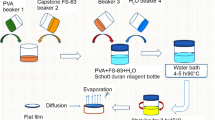Abstract
Acetylenic based surfactants have long found utility in compliant coatings such as waterborne systems and are demonstrated here to enhance performance of solventborne high solids systems. Three new additives are shown to reduce surface defects such as craters and orange peel in conventionally spray applied polyester and epoxy paints. Important to this new additive technology is the lack of adverse effect on physical properties, recoatability, and durability of the applied coating. Also discussed are the theory and background of the origins of surface defects with emphasis on the influence of additives on paint rheology, compatibility, and surface tension.
Similar content being viewed by others
References
Hill, L.W. and Wicks, Z.W. Jr., “Design Considerations for High-Solids Coatings,”Prog. Org. Coat., 10, 55 (1982).
Toussaint, A. and Szigetvari, I., “Study of the Parameters Influencing the Viscosity of High-Solids Solutions,”Journal of Coatings Technology,59, No. 750, 49 (1987).
Hill, L.W., Kozlowski, K., and Sholes, R.L., “Theory and Practice of Viscosity Reduction in High-Solids Systems,”Journal of Coatings Technology,54, No. 692, 67 (1982).
Miller, D.G., Moll, W.F., and Taylor, V.W., “Rheology Control of High-Solids Coatings,” based on a paper presented at the Annual Meeting of the Federation of Societies for Coatings Technology, Washington, D.C., 1982.
Bauer, D.R., Briggs, L.M., and Dickie, R.A., “Effect of Cross-Linked Polymeric Microparticles on the Rheology of High-Solids Coatings,”Ind. Eng. Chem. Prod. Res. Dev., 21, No. 4, 686 (1982).
Patton, T.C.,Paint Flow and Pigment Dispersion, 2nd Edition, John Wiley & Sons, New York, p. 530–604, 1979.
Rheox, Inc.,NL Rheology Handbook, A Practical Guide to Rheological Additives, 1986.
Pierce, P.E. and Schoff, C.K., “Coating Film Defects,”Federation Series on Coatings Technology, Federation of Societies for Coatings Technology, Philadelphia, PA (Revised 1994).
Fink-Jensen, P.,Farbe und Lack, 68 Nr. 3, 155 (1962).
Liu, Kou-Chang, U.S. Patent 4,720,578, 1988.
Author information
Authors and Affiliations
Additional information
7201 Hamilton Blvd., Allentown, PA 18195.
109 Lukens Dr., New Castle, DE 19720.
Rights and permissions
About this article
Cite this article
Schwartz, J., Moyer, B.A. & Smith, R.E. Control of film defects in solventborne high-solids coatings: The non-additives vs. a new additives approach. Journal of Coatings Technology 70, 71–78 (1998). https://doi.org/10.1007/BF02697843
Issue Date:
DOI: https://doi.org/10.1007/BF02697843




